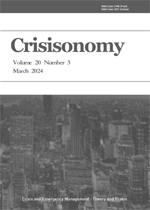소방 인력 부족 상황에서 의용소방대의 벌집 문제 해결 효과 분석
Analysis of Volunteer Firefighters' Effectiveness in the Beehive Issue amid Firefighting Shortages: A System Dynamics-GIS Approach
- 위기관리 이론과 실천
- 한국위기관리논집
- Vol.20 No.3
-
2024.0389 - 101 (13 pages)
-
DOI : 10.14251/crisisonomy.2024.20.3.89
- 24

본 연구는 기후변화로 인한 지구 온도 상승과 도시 지역에서 말벌 증가라는 사회적 문제에 초점을맞추고, 소방인력 부족 상황에서 의용소방대의 효과를 System Dynamics-GIS 모델을 사용하여 시뮬레이션하였다. 시뮬레이션에서는 Monte Carlo 방법을 사용하였으며, 그 결과로 화재 피해와 의용소방대 미투입 시 벌집 피해, 의용소방대 투입 시 벌집 피해 등이 도출되었다. 시뮬레이션 종료 시점(600초)에서평균 화재 피해는 27.18이었다. 의용소방대 미투입 시 평균 벌집 피해는 15.12였으며, 투입 시에는 4.88로감소하였다. 이러한 결과를 분석해 보면, 의용소방대 미투입 시 벌집 피해는 화재 피해의 55.63%에해당하며, 투입 시에는 17.95%로 줄어든다. 이는 의용소방대 투입으로 벌집 피해가 67.72% 감소하였다는것을 의미한다. 이 연구의 결과는 소방인력 부족 상황에서 의용소방대의 효과를 정량적으로 분석하여관련 소방정책 수립 시 기초자료로 활용될 수 있다.
This research examines the societal challenges posed by global warming and the proliferation of wasps in urban settings. It also investigates the impact of volunteer firefighters during times of firefighter shortages using a System Dynamics-GIS model. The study employs the Monte Carlo method for simulation, focusing on fire damage, beehive damage with and without volunteer firefighter involvement. After 600 seconds, the simulation revealed that average fire damage was 27.18. Beehive damage averaged at 15.12 without volunteer firefighter assistance, but this figure dropped to 4.88 with their aid. Analysis shows that beehive damage constituted 55.63% of fire damage without volunteer intervention, and only 17.95% with it. This translates to a 67.72% decrease in beehive damage due to volunteer firefighter efforts. These findings provide a quantitative assessment of the role of volunteer firefighters in scenarios of firefighter scarcity and offer critical data for developing relevant firefighting strategies.
Ⅰ. 서 론
Ⅱ. 연구방법
Ⅲ. 연구결과
Ⅳ. 결론
감사의 글
References
(0)
(0)